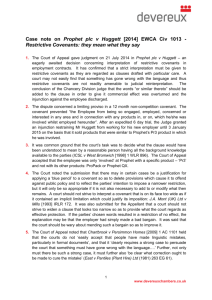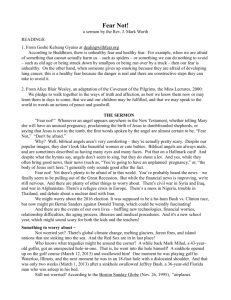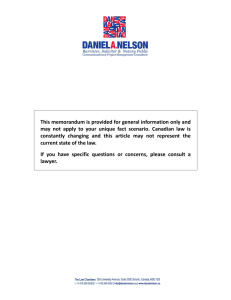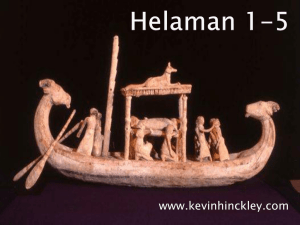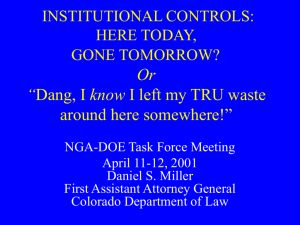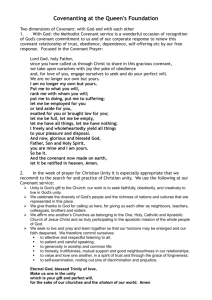Site Acquisition and Development PowerPoint
advertisement
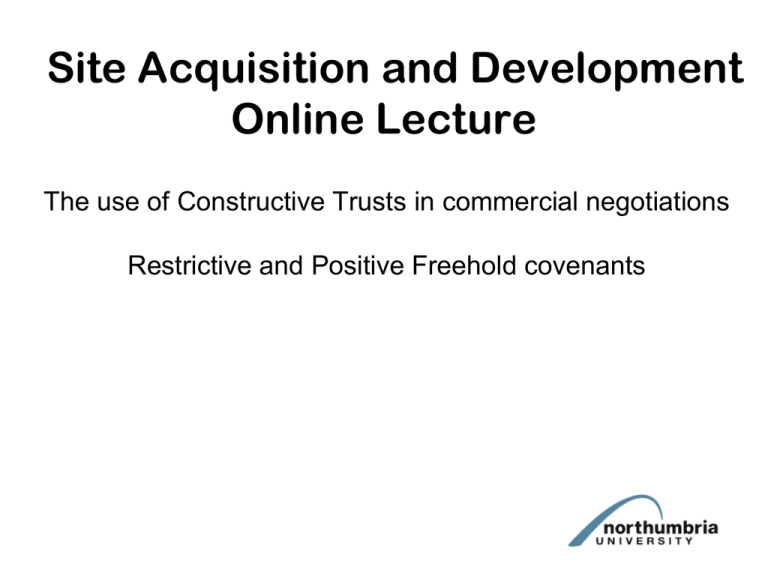
Site Acquisition and Development Online Lecture The use of Constructive Trusts in commercial negotiations Restrictive and Positive Freehold covenants Constructive Trusts of the Family Home Typically a family home scenario will involve a couple where the house is held in the name of one of them and upon breakdown of the relationship the other seeks to establish that they have a beneficial interest in the house. An interest may be awarded by the court under a constructive trust Leading case Lloyds Bank Plc v Rosset (1991) 1 A.C. 107 Constructive Trusts in Joint Venture Agreements Banner Homes Holdings Ltd (formerly Banner Homes Group Plc) v Luff Developments Ltd (No.1) (2000) 2 All ER 117 The Pallant v Morgan Equity Pallant v Morgan (1952) 2 All ER 951 Articles Constructive Trusts and non-binding agreements M.P. Thompson, Conveyancer and Property Lawyer 2001 (Conv. 2001, May/June, 265-276) The Pallant v Morgan “equity”? Nicholas Hopkins, Conveyancer and Property Lawyer 2002 (Conv.2002, Jan/Feb 35-49) Restrictive and Positive Freehold Covenants Restrictive or Positive Covenant? The general test: What is the general test? Exercise: + or -? 1. To keep no sheep 2. To use for only as a public house 3. Not to build more than 20 houses 4. Not to build within 20 yards of the boundary 5. To contribute to the cost of maintaining a shared drive 6. Not to allow the property to become infested with rabbits 7. To keep the property in good repair Restrictive Covenants – passing the burden AT LAW - the burden CANNOT pass Austerberry v. Oldham Corporation (1885). IN EQUITY the burden CAN pass PROVIDED the conditions laid out in Tulk v Moxhay (1848) 2 PH 774 (and established by subsequent case law) are satisfied [see next slide] Restrictive Covenant – Passing the Burden. Tulk v Moxhay 1. Covenant must be restrictive (negative) 2. Covenantee must retain land at date of covenant LCC v Allen [1914] 3 KB 642] 3. Covenant must accommodate covenantee’s land Restrictive Covenant – Passing the Burden. Tulk v Moxhay 4. Parties must intend the burden to run with covenantor’s land - can be express, or implied under s.79 LPA 1925 (next slide) 5. Notice/Registration requirements must be met Restrictive Covenants – Passing the Burden s.79 LPA 1925 A covenant relating to any land of a COVENANTOR … shall, unless a contrary intention be expressed, be deemed to be made by the covenantor on behalf of himself and his successors in title Restrictive Covenants – Passing the Benefit AT LAW the benefit can pass - see later BUT FIRST we will consider the rules IN EQUITY Restrictive Covenants – Passing the Benefit in Equity 3 METHODS:1. ASSIGNMENT 2. ANNEXATION 1. express 2. statutory 3. BUILDING SCHEMES (SCHEMES OF DEVELOPMENT) Express Assignment The benefit of a covenant is a chose in action Effect What is the effect of an assignment? There must be an unbroken chain of assignments Annexation means that the benefit - is ‘nailed to’ the land - becomes ‘dug into the soil of’ the land - is ‘stamped on’ the land & therefore automatically passes with the land whenever it is sold Express annexation Sample wording evidencing an intention to annex : ‘The Covtor with the intent and so as to bind the Property into whosoever hands the same may come and to benefit and protect the land retained by the Covtee or any part thereof, hereby covenants with the Covtee not to keep pigs on the Property’ Express Annexation An issue that arose in the case of Re Ballard’s Conveyance [1937] Ch. 473 If a covt. purports to annex the benefit to all the land but, in fact, only part of the land is capable of benefiting, does the benefit get annexed to that part? Statutory Annexation Addressing the issue: appropriate wording in the deed of covt The later case of Federated Homes v Mill Lodge Properties Ltd [1980] per Brightman L.J. “I find the idea of annexation of a covt to the whole of the land but not to a part of it a difficult conception fully to grasp. ..I would have thought that, if the benefit of a covt is…annexed to the land …it is annexed to every part thereof, unless the contrary clearly appears Statutory Annexation s.78(1) LPA 25 ‘A covenant relating to any land of the covenantee shall be deemed to be made with the covenantee and his successors in title and the persons deriving title under him or them, and shall have effect as if such successors and other persons were expressed’ Statutory Annexation Brightman LJ: “if the condition precedent of s.78 is satisfied, that is to say, there exists a covenant which touches and concerns the land of the covenantee, that covenant runs with the land for the benefit of his successors in title …” Building Schemes THE EFFECT OF A BUILDING SCHEME ‘A local law’ All purchasers of plots in the scheme can enforce the restrictive covts between themselves (irrespective of the date on which they or their predecessors in title bought their plots). Building Schemes What are the two requirements for a building scheme? - Elliston v. Reacher [1908] 2 Ch 374. Re Dolphin’s Conveyance [1970] 2 All ER 664 Positive Covenants – Passing the Burden AT LAW & IN EQUITY the BURDEN of POSITIVE COVTS CANNOT pass Austerberry v. Oldham Corporation (1885) 29 CHD 750. Rhone v Stephens (1994) 2 ALL ER 65 per L.Templeman: [it is knowledge] imparted at an elementary stage to every student of the law of real property that positive covenants affecting freehold land are not directly enforceable except against the original covenantor Positive Covenants – Passing the Burden Indirect methods of enforcement include:1. the rule in Halsall v Brizell [1957] Ch 169 see next slide) 2. creating a chain of indemnity covenants E R sells to S sells toT i.c i.c. 3. E requiring a direct covenant from each successor Also: 4. creating a long lease when the property is first sold 5. creating, instead of a covt, an easement of fencing (in the case of fencing!) Halsall v Brizell A successor cannot take the benefit of an agreement unless he also accepts its related burden Halsall v Brizell Rhone v Stephens The burden must be RELATED to the exercise of the right which gives the benefit; & The successor must be able to choose whether or not to accept the benefit Thamesmead v Allotey (21st January 1998 LSG 28) Passing the benefit at law Smith & Snipes Hall Farm Ltd v River Douglas Catchment Board [1949] 2 KB 500 1 The covenant must touch and concern the land of the original covenantee: P&A Swift Investments v Combined English Stores Group [1989] AC 632 2 The covenant must have been intended to benefit the covenantee’s land at the time it was made and it must have been intended for this benefit to run with the land - express words - implied under s.78(1) LPA 1925 Passing the benefit at law 3. The original covenantee must have held a legal estate in the benefited land at the time the covenant was made 4 A successor in title must have acquired a legal estate (but it does not need to be the same legal estate as the original covenantee) Smith & Snipes Hall Farm Ltd v River Douglas Catchment Board Mrs. Smith (freehold) Purchaser (freehold) Tenant (leasehold) Discharge of Covenants Automatic discharge: dominant and servient land in same ownership Application to the Lands Tribunal to discharge or modify the covenant s.84(1) LPA 1925 Application for Discharge of Covenants An application can be made to discharge or modify ‘any restriction arising under a covt. or otherwise as to the user [of land] or the building thereon’ Grounds to be established: 1. Obsolescence 2. Impediment to reasonable user 3. Holders of the benefit of the covt have agreed to its discharge 4. No injury to the holders of the benefit (plus certain additional factors) Tribunal has power to order compensation

